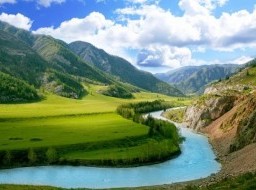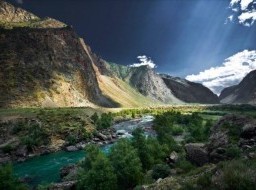Ethno-natural park "Uch-Enmek"
Karakol Nature Park Uch-Enmek is a specially protected area in the Ongudai district. It was established in 2001 by a decree of the Government of the Altai Republic. In the park there are a lot of cultural and historical monuments of different times and places sacred for Altai people. In 2011, the park expanded - it was joined earlier by the autonomous park "Argut", located 90 km south of the regional center Onguday. The park was named after the sacred mountain Uch-Enmek. In translation from the Altai "uch" means "three" and "enmek" is the peak: the Uch-Enmek mountain has three peaks, the highest of which reaches an altitude of 2821 m. Cluster section "Uch-Enmek" is located on the northern slope of the Terektinsky ridge. The area of the park is 60551 hectares, the whole of its territory is divided into three functional zones: a reserved zone, encompassing the rock massif of the Uch-Enmek mountain, all activities are prohibited here; especially protected, covering the watershed part of the Terektinsky Range within the highland zone, strictly regulated visits are allowed here, as well as grazing of cattle; recreational where it is allowed to conduct regulated excursion and tourism activities and traditional management with observance of the park's protection regime. The park was created to preserve the monuments of natural and historical and cultural heritage of the indigenous population of the Altai Mountains. With its help, the traditionally established original culture of the population, which represents a unique natural and ethno-cultural complex, develops spiritual and ecological, scientific and health-improving tourism, based on ethno-ecological traditions of Altaians and Old Believers. Many natural objects in the park are sacral. To one of these places - the sacred mountain Uch-Enmek - a common man can not even be approached. Previously, they went there only accompanied by shamans, performing the rituals of thanksgiving along the way. Separate photographing of the mountain is also not welcome: you can only capture yourself in memory of yourself against its background. Throughout the park you can find traces of ancient cultures, including Afanasievskaya (3 thousand years BC), Karakol (1,5 years BC), Scythian (VIII - IV centuries BC) , Turkic (VI-VIII century AD). A lot of stone steles, mounds, balbalov, rock paintings give guests a unique opportunity to feel the extraordinary atmosphere of these places, plunge into the history and the worldview of another people. The most visited places of the Karakol valley include a complex of petroglyphs near the village of Bichiktu-Bohm, the sacred Lake Aru-Kem, the Bashadar sacral complex, the finds of which are kept in the State Hermitage and the State Historical Museum. The animal and plant world of the park is diverse. Its territory is inhabited by gophers, roe deer, mountain goats, lynxes, squirrels, badgers, bears, many birds. Representatives of such Red Book species as the snow leopard, the crane-crane, the black stork, the golden eagle, etc. also live here. In the mountain lakes there are grayling, trout, crucian carp. Centuries old cedars, juniper, edelweiss, berries - everything that the flora of Altai is famous for can be seen on the territory of the park. In the valley, Kuril tea also grows, from which a very tasty and wholesome drink turns out, many kinds of rare plants (onion Altai, Radiola frost, Altaic rhubarb, tea penny, etc.). When visiting the park, it should be remembered that this place plays a special role in the culture of another people, therefore it is necessary to respect its traditions and foundations. In addition, it is an opportunity to look at the world at least as much as the indigenous population of the valley does. |








